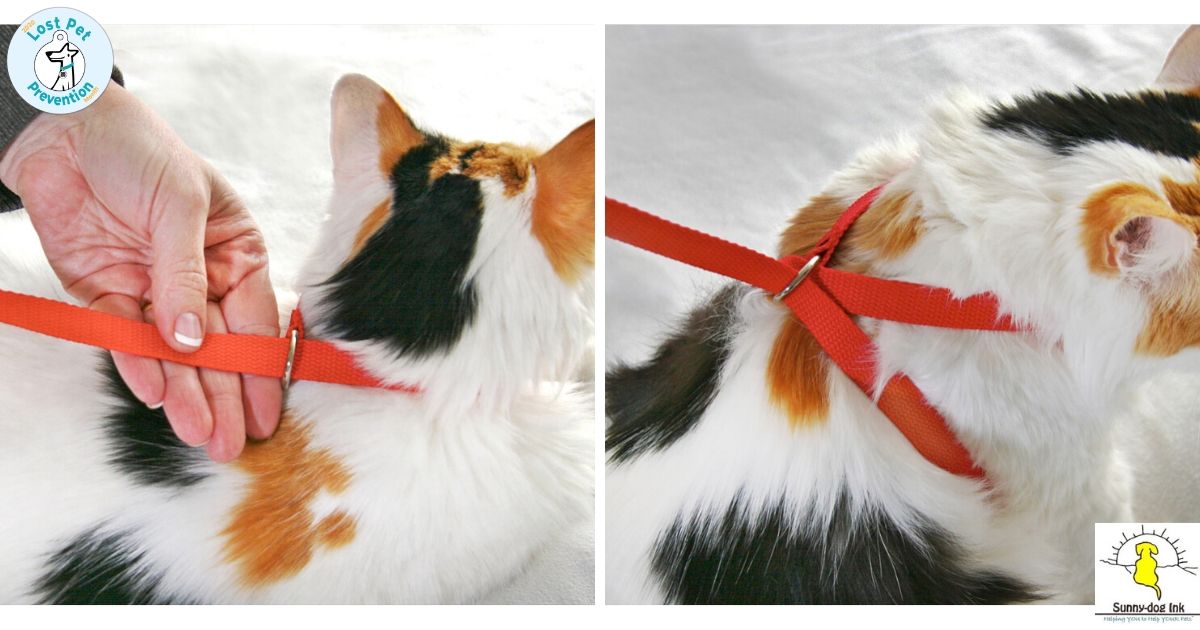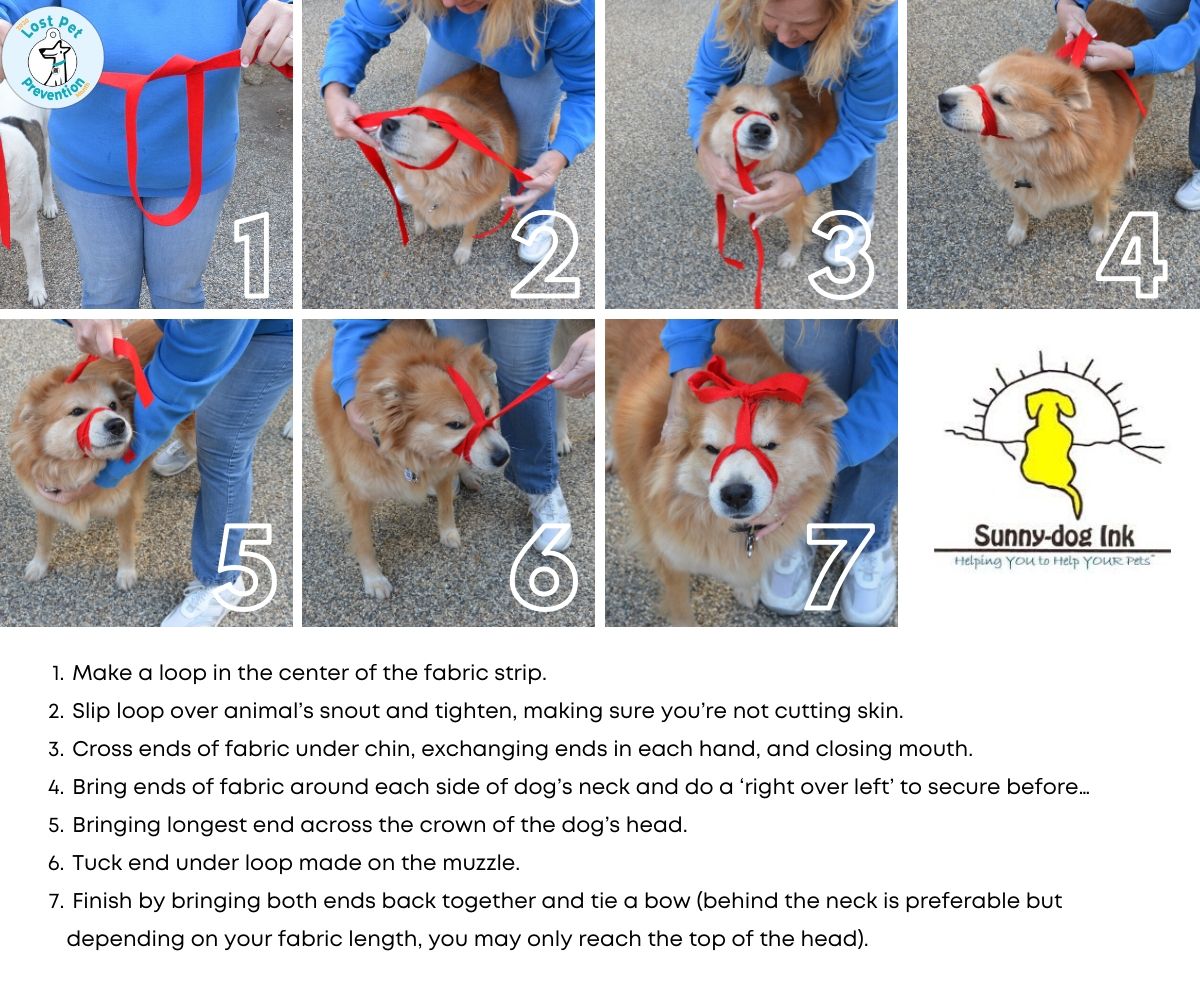This is a featured guest post for Lost Pet Prevention Month 2020. Written by Denise Fleck, The Pet Safety Crusader™
Cold and tired, with paws sore from miles traveled. Tummy grumbling due to lack of a decent meal, scavenging back alley garbage cans for days on end. Desperately in need of rest where both eyes can close shut without fear of being hunted. Sorely missing his humans and the comfort of home. This is the plight of a lost family pet, and even worse, illness and/or injury sometimes add to the problems faced by man’s and woman’s best friend.
Those lucky souls who have never lost a furry family member, upon seeing a stray dog, may wrongly conclude that the pet has been abandoned, or that his owners failed to keep him safely confined at home. Even the best of pet parents are sometimes outwitted by a curious dog with rambling paws, who finds himself lost and afraid. Like you, the canine’s family of humans may be frantically looking for their best friend, so carefully take the steps you would hope someone else would take if it was your fur child that had taken flight.
At the very least, have a few items ready to go:
- 6 ft. Slip lead/leash, preferably with an “o” or “d” ring
- Thick bath towel
- Treats, water and bowl
- Pet First Aid Kit
- Variety of muzzles or muzzling material
Safe Approach
- If you are driving when you spy a stray pet, do NOT slam on the brakes and stop your car in the middle of the road to jump out, endangering other drivers. Look in your rear-view mirror, signal and pull your car completely off the road. Next, turn off the ignition, hit the parking brake, and pop on your hazard lights. Be aware that any sudden move, even opening the car door, could spook a scared animal and cause him to bolt, potentially into traffic! Notice everything around you -- downed power lines, other animals or people, glass and dangers you need to avoid.
- Inhale deeply, then exhale. Doing so, will help you focus and remain calm as you slowly approach the pet in need. Although you want nothing more than to help this poor creature, the dog may not understand your enthusiasm. Dogs, injured or not, are excellent at reading emotional cues, so staying calm is best to keep the pet’s anxiety at bay. Observe body language for signs the pooch is in pain or is about to lunge or bite. If you get bitten, you won’t be any help to the pet. Flattened ears, yawning, lip licking and panting hard are common behaviors expressed by a fearful dog.
- Toss treats to lure the animal out from hiding and bring him closer, into sight. Always position your body sideways to appear less threatening, and do not make direct eye contact. Use a calm gentle voice to call to him, but do not approach if he growls.
Wrangling and Lending Aid to an Injured Dog or Cat
If you have a barrier to protect yourself as you approach (a backpack or cushion for instance), get it slowly in front of you. Also, grab a 6 ft. slip lead like this one that can easily be made into a figure 8 harness by looping once around the dog’s neck, and then bringing the lead around the chest, behind the front legs, back up the other side and securing by slipping the handle through the “O” or “D” ring.

Small pets can be held secure by swaddling in a thick bath towel which can control the head and thwart escape. Positioning a rolled towel under a dog’s lower jaw and wrapping the ends around his neck like a cervical collar, is another option for controlling the sharp end of a pet. You will, however, also need to have a leash or other form of restraint to keep the body stationary.
Doing the best with what you have, wherever you are, is the motto! You can also improvise a muzzle out of any soft fabric about an inch wide: leash, gauze roll, triangular bandage, panty hose, sash. No rope, string or anything narrow that could cut the snout. The point is to keep yourself safe and in control, so that you can render aid.

- Never leave a muzzled animal unattended -- he is defenseless!
- If a muzzled animal experiences breathing difficulty, vomiting or seizures, they could easily suffocate.
- Remove muzzle immediately if such signs or symptoms occur.
Once the pet is restrained, and if you can do so safely, gently perform a Head-to-Tail check, looking for signs of injury. If you touch a sore spot or move a limb into pain, you could suddenly have teeth penetrating your skin if you haven’t properly muzzled and restrained the animal, so stay alert. Basics learned in a Pet First Aid Class are priceless, but prioritize:
- Is the animal breathing and does he have a pulse? If not, begin CPR!
- Bleeding injuries? Direct pressure, elevation & pressure points before bandaging to minimize blood loss and prevent infection.
- Gum color? If capillary refill time is ˃2 seconds, or if gums are pale, treat for Shock by increasing circulation and keeping pet warm, and get to the vet at once!
- Are there potentially any back or neck injuries or broken bones? Careful transportation is vital.
Depending on what you find, your first aid knowledge will tell you where to begin before transporting the pet to safety and additional medical help. If he has a collar with ID, making that phone call will be your next step.
Transporting An Injured Animal
If the pet you’re trying to help is a medium to large dog, and if he can get to his feet, placing a towel or even a grocery tote (cut an inch off each side so that opens with a handle on each end) placed under the abdomen in front of the hind legs, can serve as a back-end sling to assist walking. If the animal is immobile, a make-shift stretcher can be created by carefully sliding a towel or tarp underneath him. If you have a helper, you can lift the pet by holding the ends taut to carry him to safety. If you are alone, slide the tarp or blanket gently under the pet, and on a smooth flat surface, pull one corner of the fabric carefully bringing the pet along with it.
Boards of all kinds can also be used as backboards if you suspect back or neck injuries. Some car mats and SUV liners are quite sturdy, a storage box lid, cookie sheet, surfboard or toboggan are other ideas depending on the animal’s size. Carefully secure the pet to the board before lifting, restraining him with torn sheet fabric, leash or other straps.
Do not attempt to carry an animal on any kind of improvised backboard device if the animal is struggling or resisting the restrain as this could cause additional injury.
Where To Take An Injured Pet
After administering first aid to prevent further injury, and hopefully reduce pain, but in extreme cases, applying extraordinary efforts to prevent death (CPR for instance), you need to determine your next steps…where to take the injured pet?!
Veterinarian
Obviously, the best choice if the pet is seriously injured. If you choose to take the injured animal to an animal emergency hospital or veterinary clinic, however, make sure you are willing and able to assume financial responsibility for the pet. There are no guarantees the pet’s owner (if located) will reimburse you, and veterinarians get more requests than they can afford to handle pro bono from good Samaritans wanting help for a stray.
Animal Control
If the local Animal Control is nearby, that would be a good choice, especially if the animal is not critically in need of medical care. Knowing if your AC has a veterinarian on staff round-the clock might help you better decide. Understand however, shelters often cannot provide expensive surgeries and sometimes must make the painful decision to euthanize injured animals to relieve suffering.
Even if you proceed to a vet clinic, let Animal Control know that you have located a lost pet, where you are taking him and leave your phone number in case the worried family comes looking for their furry family member. In situations where you cannot safely restrain and transport the animal, calling AC is truly your best bet to help the pet get the care he needs, and hopefully his way back home.
Your Home
Even if you are motivated to locate the pet’s owners yourself and are willing to post flyers to online services like petfinder.com, please contact your local animal shelter first in case the owners come looking for their friend. It’s always a good idea to let the shelter scan the pet for a microchip even if you wish to take him home. Also, consider your home situation: Are there other people and/or animals that will object or not get along? What if the lost pet is sick, fearful of or aggressive towards other pets, can you keep him separate? It’s also important to know local laws – finders keepers does not apply in all municipalities. And consider if you will be willing to return the lost pet to his original home if the owner turns up once you have bonded with him.
The best rule of thumb is to do what you would want the finder of your pet to do if they found your precious fur baby injured and without a collar. Likely, take your pet to the vet and try to locate YOU! Considering though how much you can afford and physically is a big part of the equation.
As mentioned before, do your doggone best to keep your pet safely contained at home and always, always make sure your pet carries ID (preferably with a QR code) and a microchip, both connected to your most up-to-date contact information. Before tragedy strikes, be sure to practice your animal handling skills and learn or brush up on your pet first aid skills. If you don’t use it, you lose it, and also, protocol changes, so you’ll want to know the best methods to help an animal you find lost and injured.
Denise Fleck is the Pet Safety Crusader™ having personally taught more than 20,000 humans to rescue Rover or help Fluffy feel better. Her mission is to help YOU make a difference in the life of an animal through Pet First-Aid, Senior Pet Care and Disaster Preparedness classes, her “The Pet Safety Bible,” and the dozen other books she has penned. Learn more at www.PetSafetyCrusader.com
All photos are courtesy of Sunny-dog Ink


